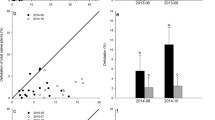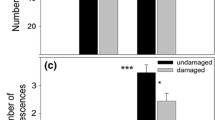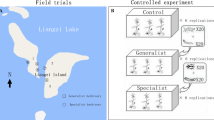Abstract
Blossey and Nötzold (1995) recently hypothesised that the increased vigour of certain invasive plant species has been at the expense of defences against natural enemies. A prediction of their evolution of increased competitive ability (EICA) hypothesis is that invasive genotypes are relatively poorly defended. We tested this prediction with herbivore bioassays and with direct quantification of plant secondary metabolites comparing non-indigenous genotypes of Lythrum salicaria L. (purple loosestrife) with indigenous forms. The herbivore bioassays revealed no significant intra-specific variation in herbivore resistance between indigenous and non-indigenous hosts. The phenolic content of L. salicaria leaves was significantly higher in indigenous genotypes, as predicted by the EICA hypothesis. The average phenolic content of leaves (regardless of their origin) was, however, low, implying that the role of plant phenolics in purple loosestrife anti-herbivore defence is probably limited. It is suggested that the EICA hypothesis, as tested in the current study, does not explain the increased vigour of L. salicaria in non-indigenous habitats.
Similar content being viewed by others
Author information
Authors and Affiliations
Additional information
Received: 10 April 1999 / Accepted: 11 May 1999
Rights and permissions
About this article
Cite this article
Willis, A., Thomas, M. & Lawton, J. Is the increased vigour of invasive weeds explained by a trade-off between growth and herbivore resistance?. Oecologia 120, 632–640 (1999). https://doi.org/10.1007/s004420050899
Issue Date:
DOI: https://doi.org/10.1007/s004420050899




